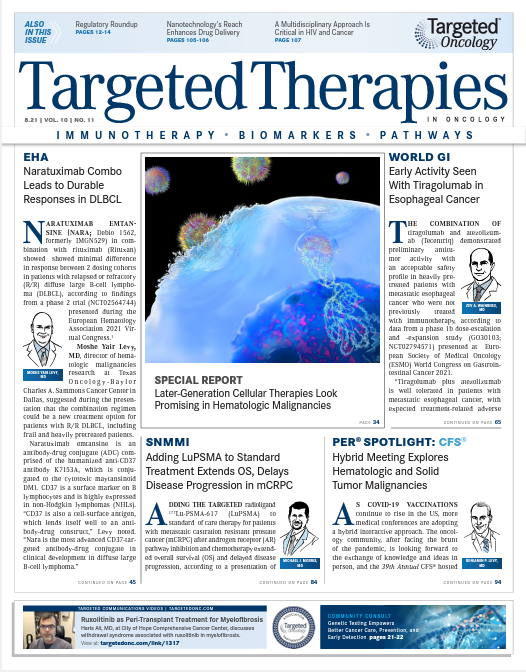Exploring Off-label Use for 177Lu Dotatate in Nonneuroendocrine Tumors
The benefit of using a drug off-label is that it may provide the best available intervention for a patient with no other option.

Although the approval of 177Lu dotatate (Lutathera) in 20181 marked a welcome addition to the treatment of somatostatin receptor–positive neuroendocrine tumors (NETs), including foregut, midgut, and hindgut neuroendocrine tumors in adults, there remain subsets of patients with rare nonneuroendocrine malignancies for which Lutathera has shown promise. Seyed Mohammadi, MD, at University of Pittsburgh Medical Center in Pennsylvania, discussed the rationale for off-label clinical use of 177Lu during a presentation at the Society of Nuclear Medicine and Molecular Imaging (SNMMI) 2021 Virtual Annual Meeting.2
“Off-label use of a drug is its use for unapproved indications or extended usage,” Mohammadi, a supervisor in the nuclear medicine department at UPMC, said during his presentation. Mohammadi pointed out current challenges associated with the treatment.
For example, the cost for a single dose of 177Lu is over $50,000 and private insurance coverage requires preauthorization approval. Medicare will cover the cost but only accepts FDA- approved ICD 9/10 codes. An oncologist may argue for its use based on National Comprehensive Cancer Network recommendations but these only provide a road map for treatment.
Despite these challenges, “it’s our job to work with insurance companies to [get this covered] to help some of our patients, [especially] because some of these patients have limited treatment options available,” Mohammadi said. “We should not take this treatment option off the table for them.”
Off-label use is generally legal unless it violates ethical guidelines or safety regulations, Mohammadi said. Also, a medical center’s pharmacy and therapeutics committee could provide guidance on off-label use.
Mohammadi pointed out questions to help develop the rationale for off-label use of 177Lu, a radionuclide-targeted therapy (RNTT); these questions focused on identifying the most appropriate candidate for RNTT and include determining the heterogeneity of NETs before treating the patient with an RNNT, and whether heterogeneity of NETs help determine outcome. Further questions involve determining the best course of treatment of NET and what the potential is for combination RNTT treatment.
To better inform clinical decision-making, Mohammadi cited the research of Chan et al, which evaluated the use of a grading scheme that could describe the joint results of fluorodeoxyglucose and somatostatin receptor imaging PET scans.3 The combined parameter, called the NETPET grade, significantly correlated with overall survival by univariate analysis (P = .0018). The NETPET grade was compared with other clinical data such as WHO grade and overall survival. Investigators noted that the WHO grade at the time of diagnosis did not correlate with survival. The investigators concluded in their study that the “NETPET grade has promise as a prognostic imaging biomarker in neuroendocrine tumors. It permits the capturing of the complexity of dual radiotracer imaging in a single parameter which describes the subjects’ disease and is readily amenable to use in patient management and further research.”
Throughout his presentation, Mohammadi identified patient cases in which 177Lu was used in off-label and extended use. These included cases of patients with midgut NETs and carcinoid syndrome, paraganglioma, pheochromocytoma, esthesioneuroblastoma, and meningioma. According to statistics from the American Society of Clinical Oncology's Cancer.net website, more than 12,000 individuals in the United States are diagnosed with NET each year, with about 175,000 living with the diagnosis. In general, NET accounts for only 0.5% of all malignancies.4
The benefit of using a drug off-label is that it may provide the best available intervention for a patient with no other option, said Mohammadi. But he cautioned that it could cause harm because of a lack of investigation. Mohammadi did emphasize, however, that 177Lu has been shown to be safe in NETs, just not in these small subsets of rare malignancies.
From a legal perspective, the ability to prescribe a drug off-label is left to the physician’s discretion, Mohammadi said. But he added that the moral and ethical dilemma is whether or not to treat some patients with a particular disease based on their financial or insurance coverage. “I hope that we don’t get to the point where we have to separate patients based on their [financial or insurance coverage] situation and tell them that we can’t help them,” Mohammadi concluded.
References:
1. FDA approves new treatment for certain digestive tract cancers. News release. FDA. January 26, 2018. Accessed July 16, 2021. https://bit.ly/3ilehW8
2. Mohammadi S. Updates in lutetium dotatate focused on retreatment and managing heterogeneity. Presented at: Society of Nuclear Medicine and Molecular Imaging 2021 Virtual Annual Meeting; June 12-15, 2021; virtual. Abstract TS15. Accessed July 14, 2021. https:// bit.ly/3hHe1ll
3. Chan DL, Pavlakis N, Schembri GP, et al. Dual somatostatin receptor/FDG PET/CT imaging in metastatic neuroendocrine tumours: proposal for a novel grading scheme with prognostic significance. Theranostics. 2017;7(5):1149-1158. doi:10.7150/thno.18068 4. Neuroendocrine tumors: Statistics. Cancer.net. Updated February 2021. Accessed July 16, 2021. https://bit.ly/2UmeSyR
